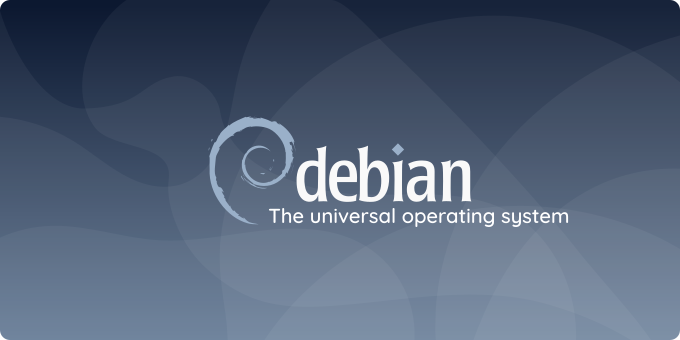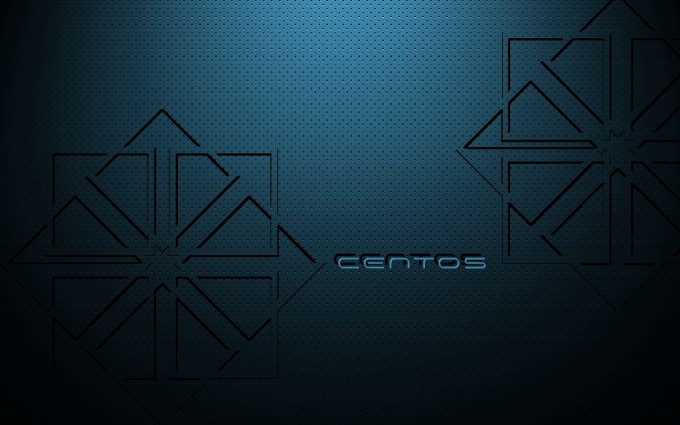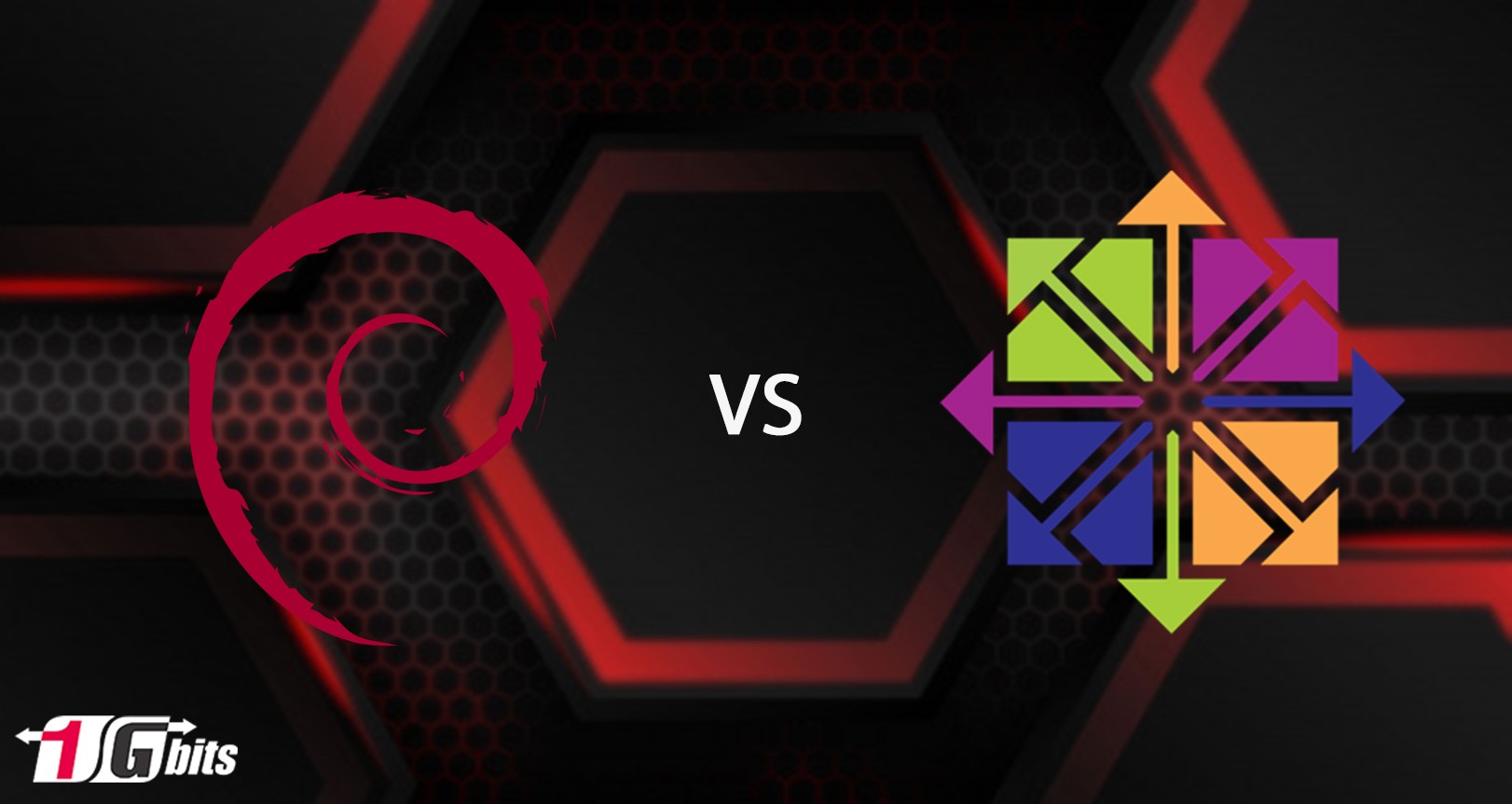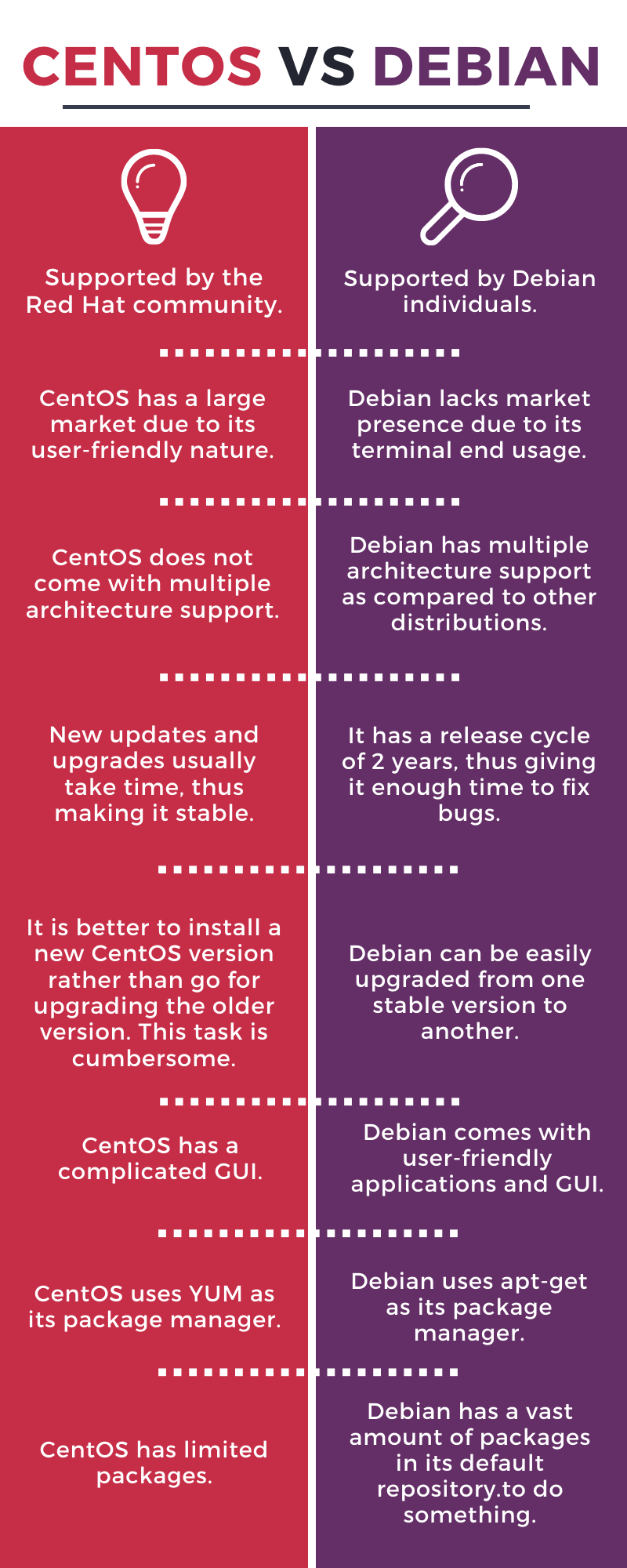CentOS and Debian are on top of the list of Linux distributions. While having loads of choices from the list of Linux distros, choosing the right one might be challenging. In this article, we will compare and differentiate Debian vs Centos.
Choosing CentOS or Debian can be difficult as both have advantages in various parameters. CentOS is an open-source Linux distribution that big enterprises use for server building. A large community and Red Hat Enterprise mainly support it.
On the other hand, Debian is also open-source and backed by members of the Debian project. Debian is the largest community-driven open-source Linux distribution.
Before understanding the difference between Debian and CentOS.
What is Debian?

Debian is considered to be the oldest Linux-based distribution as it was launched in 1993. It is an open-source operating system created by individuals with common interests to develop this free OS.
To install Debian, you can buy the CD-ROM distributions of Debian or burn your CD-ROMs from the image available over the internet. Click here to download the installation image file for Debian.
Debian ensures the security and stability of your system. Debian uses two types of kernels- Linux kernel and FreeBSD kernel. Debian is a commonly used OS for personal and network servers and is a base for other Linux distributions.
To ensure you're always running the most up-to-date version of Debian, it's important to know how to check the Debian version on your system. Learn how to check your Debian version to keep your server secure and stable.
Features of Debian
- Debian server comes with a wide range of installers compared to other distributions.
- Its community members still maintain Debian.
- It comes with an easy installation package.
- With Debian, you can use any software available for distribution.
- Debian supports multiple hardware architectures.
- Debian can be easily transitioned between new and old technologies.
- Debian comes with well-integrated packages.
- It adapts easily during an upgrade to the new release.
- Debian is by far the most secure and stable Linux distribution available to date. It has a bug-tracking system to resolve issues.
Advantages of Debian
- Debian is the oldest version and has a much more mature community.
- Debian's tested version is as stable as other distributions, and even Debian's stable distribution is rock-solid stable.
- Debian offers the largest repository for the software as compared to any other distribution.
- Debian's tools intend to do recursive system upgrades.
- The Debian package will notify you to install another package if required for working; it is up to you to install it.
- The system works on a policy that allows it to maintain the distribution in a distributed manner.
- Debian has a stable branch that tests packages before release.
- It is known for being consistent and maintaining a highly secure system.
- It supports almost every available Kernel-maintained CPU instructions set.
- The installation is minimal, thus making it easier for server resources and their security.
Disadvantages of Debian
- New software needs to be upgraded to get a stable repository. Still, sometimes it is difficult to get the latest features and software updates as fast as it is available for other distributions.
- If you are an experienced person to work at the terminal end, then interacting with the system is easy. It gets a bit challenging for new users to get them working for the first time and is less user-friendly.
- It does not have an enterprise version like other distributions that offers you to work with large companies and their projects.
- Debian offers an extended support cycle that even your hardware will probably get recycled before its support cycle ends.
- Though Debian works well with VMs, it still faces unexpected issues like sudden reboot, server clock stuck, etc.
What is CentOS?

CentOS was released in 2004 and has been an open-source software. It is an enterprise-class Linux distribution supported by the Red Hat community. It is considered to be the replica of Red Hat Enterprise Linux (RHEL) and is commonly used in the IT world on a large scale.
Being similar to RHEL, it allows you to develop in a more dominant and the best Linux distribution. CentOS is the most popular distribution when it comes to server environments.
Due to RHEL support, CentOS ensures enterprise-level security, thus making it safe for users. It is highly customizable and stable.
To gain a deeper understanding of CentOS and its key features, check out our detailed guide on What is CentOS, which highlights its history, benefits, and why it’s widely used in server environments.
Features of CentOS
- It comes with many security in-built features that help protect from cyber-attacks using SELinux. It helps to reduce the vulnerabilities of privilege escalation attacks.
- Many organizations prefer it due to its extended support cycle.
- It uses the Yellowdog Update package manager that keeps your system up-to-date. This feature ensures that you can easily add or remove features from your application irrespective of your application phase.
- CentOS comes with a great and simple document that allows you to install and configure CentOS on your system efficiently.
- It can support multiple management platforms like cPanel, WebMin, Docker, etc.
Advantages of CentOS
- CentOS is a complete workhouse with stable distribution.
- You can ensure easy updates of the system and security with YUM.
- It allows you to install multiple PHP versions that are available for different users.
- As it has Red Hat backup, most of Red Hat's instructions work the same for CentOS, like a package manager.
- It comes with built-in management tools for containers.
- CentOS comes with RPM package compatibility that allows easy machine setup for development.
- It has a customized command line that ensures easy automation of new instance deployments.
- It has Docker compatibility.
- It can even provide high performance on average hardware.
- It ensures easy and quick deployments.
You can easily verify your current CentOS version to ensure compatibility and take advantage of the latest features. For a detailed guide, check out our post on How to Check CentOS Version.
Disadvantages of CentOS
- It may not work well for a desktop (GUI) Linux distribution.
- While working, it may get complicated due to the C/C++ library's dependency issues.
- It is a cumbersome job to install and uninstall the packages in RHEL.
- It has a weak user interface.
- It comes with a small user base as compared to other distributions.
- It lacks robust driver support as compared to other distributions.
- You may face issues while configuring network interfaces.
CentOS vs Debian: Head-to-head Comparison

Both Linux distributions are great and are commonly used based on their features. Both of them are used to run millions of applications and are used by many developers. Still, both are used in different scenarios and are different from each other in many aspects.
|
Parameters |
CentOS |
Debian |
|
Community |
Supported by the Red Hat community. |
Supported by Debian individuals. |
|
Market Presence |
CentOS has a large market due to its user-friendly nature. |
Debian lacks market presence due to its terminal end usage. |
|
Architecture Support |
CentOS does not come with multiple architecture support. |
Debian has multiple architecture support as compared to other distributions. |
|
Release Cycle |
New updates and upgrades usually take time, thus making it stable. |
It has a release cycle of 2 years, thus giving it enough time to fix bugs. |
|
Version Upgrade |
It is better to install a new CentOS version than upgrade the older version. This task is cumbersome. |
Debian can be easily upgraded from one stable version to another. |
|
User Interface |
CentOS has a complicated GUI. |
Debian comes with user-friendly applications and GUI. |
|
Package Manager |
CentOS uses YUM as its package manager. |
Debian uses apt-get as its package manager. |
|
Package Number |
CentOS has limited packages. |
Debian has a vast amount of packages in its default repository. |
Key Difference between Debian and CentOS
- If you want up-to-date packages, you should consider using Debian as it provides an easy and effortless transition from one version to another version compared to CentOS.
- CentOS comes with a complicated GUI that is still easy to manage as compared to Debian. So if you are handy with CentOS, then there is no way you should move to Debian.
- If you use these distributions as a server, you should select CentOS as long-term support and updates.
- Debian is mostly preferred by experienced users who want to work as an admin. In contrast, a business person mostly prefers CentOS who wants a stable and secure Linux distribution for their applications.
Conclusion
Both Linux distributions, Debian vs CentOS, are commonly used and preferred by many developers based on their business needs. Both distributions handle different scenarios and are suitable for various applications.
It is up to the developers which distribution suits well for their development. Undoubtedly, both distributions are preferred to install on their server. Today, CentOS is being used to run several servers more than any other distribution to run the server. If you consider it easy to work, CentOS server has more stability and features than Debian.
You can order your own Linux VPS server and practice everything, whether it's setting up a web server, managing databases, or running scripts. For those specifically interested in Debian VPS, it's a great choice for users who prefer stability and a large repository of packages. You’ll be able to experiment with package management using APT and explore the distinct file structure that Debian offers compared to other distributions like CentOS. Let us know what other differences we missed between CentOS and Debian, and share your experiences of working with a VPS Debian.
People are also Reading:
![Debian vs CentOS: Differences You Should Know [Comparison] Debian vs CentOS: Differences You Should Know [Comparison]](https://1gbits.com/cdn-cgi/image//https://s3.1gbits.com/blog/2021/02/debian-vs-centos-comparison220-847xAuto.jpg)










